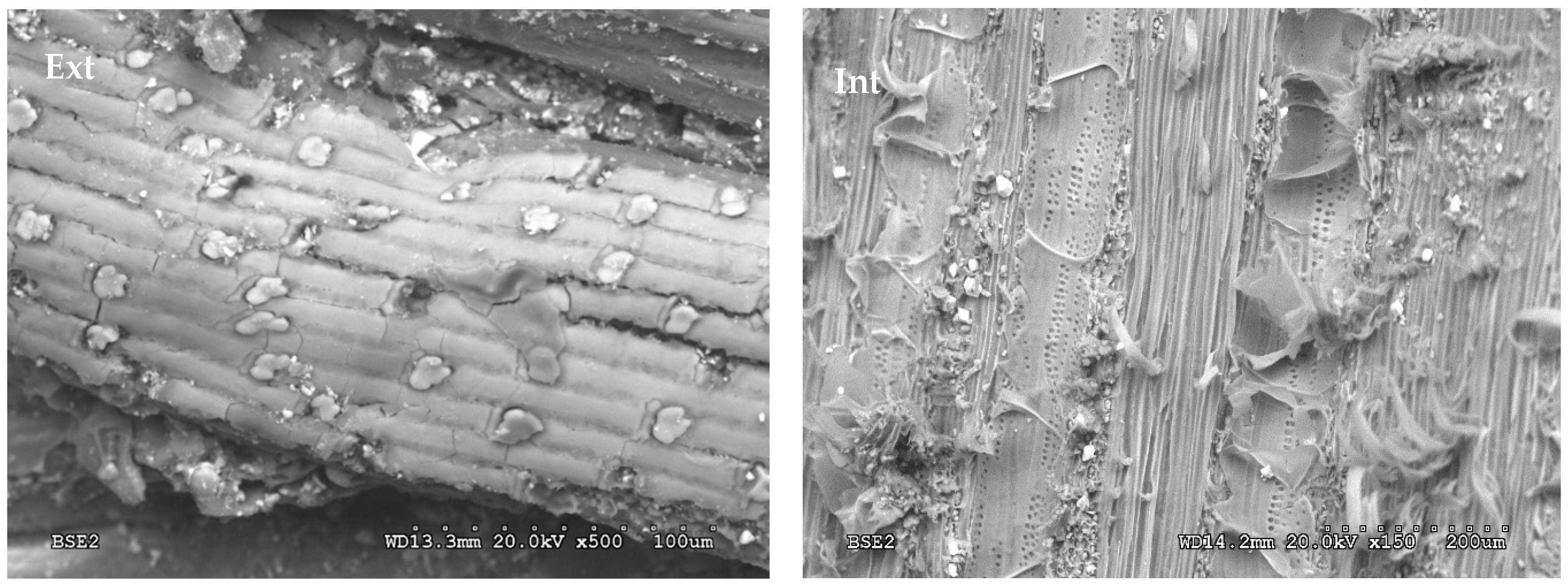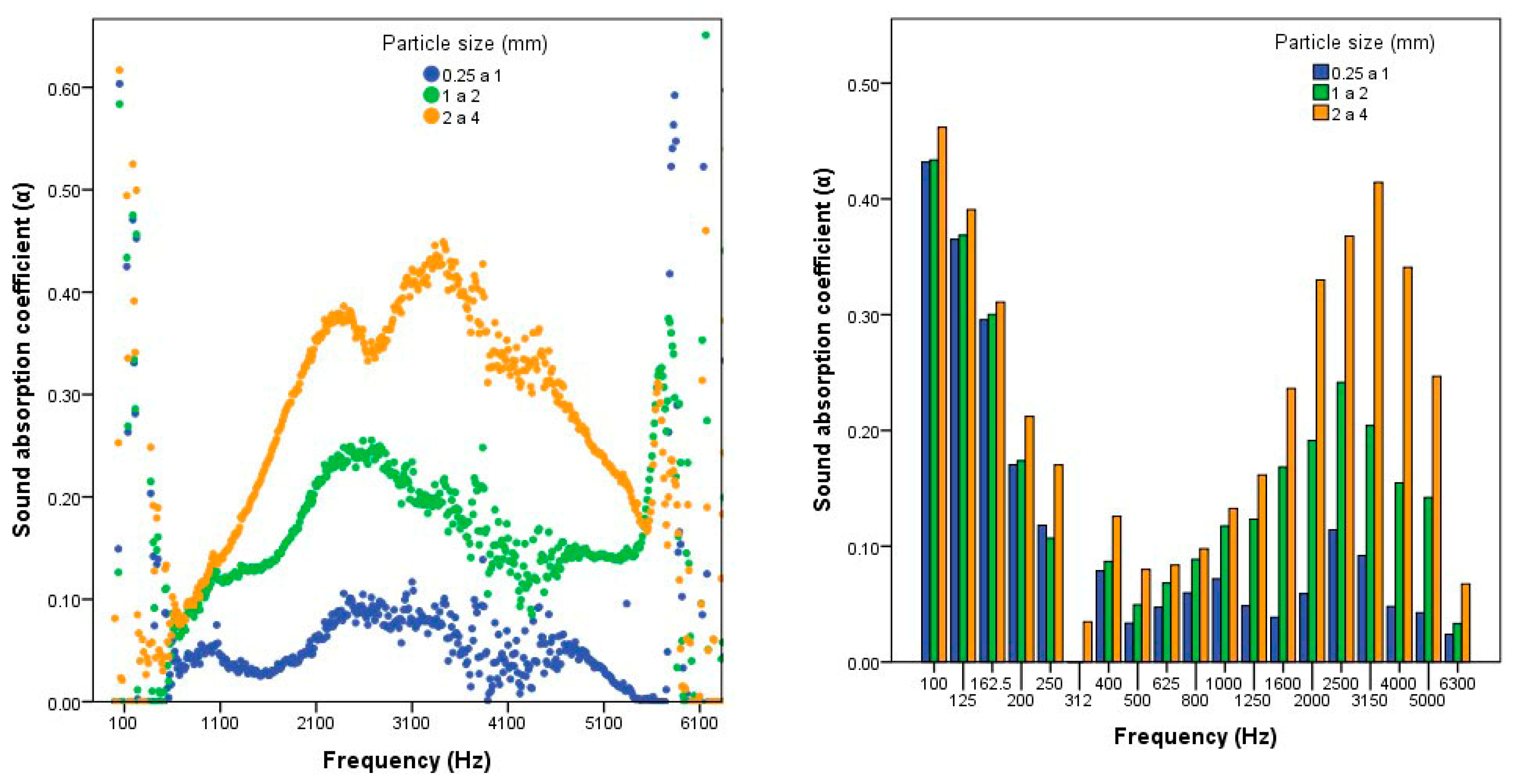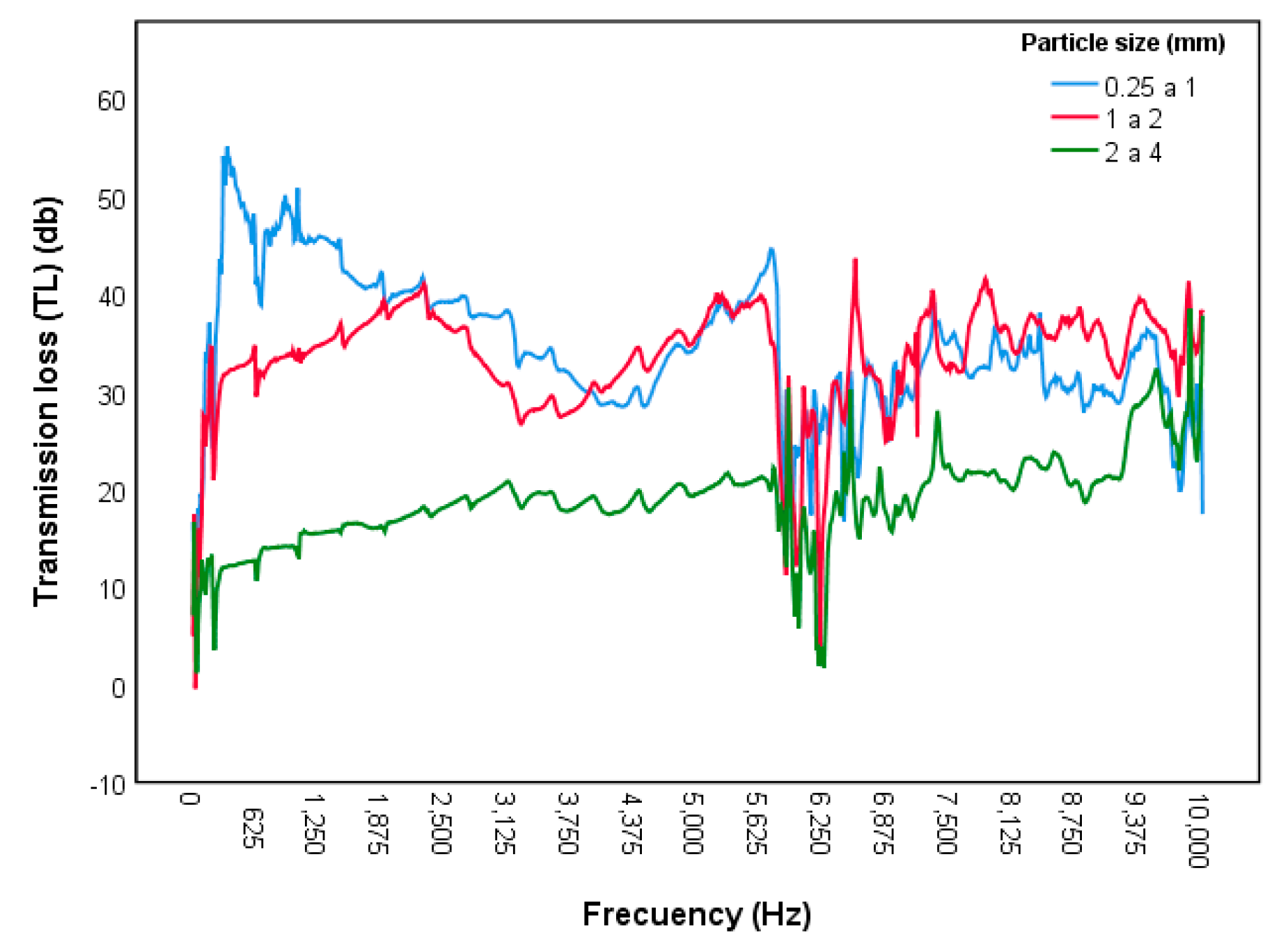Assessment of the Physical, Mechanical and Acoustic Properties of Arundo donax L. Biomass in Low Pressure and Temperature Particleboards
Abstract
1. Introduction
2. Materials and Methods
2.1. Materials
2.2. Manufacturing Process
2.3. Methods
3. Results and Discussion
3.1. Scanning Electron Microscopy
3.2. Physical and Mechanical Properties
3.3. Acoustic Properties
4. Conclusions
Author Contributions
Funding
Acknowledgments
Conflicts of Interest
References
- Velázquez-Martí, B.; Sajdak, M.; López-Cortés, I. Available residual biomass obtained from pruning Morus alba L. trees cultivated in urban forest. Renew. Energy 2013, 60, 27–33. [Google Scholar] [CrossRef]
- Turgut Sahin, H.; Burak Arslan, M. Weathering performance of particleboards manufactured from blends of forest residues with Red pine (Pinus brutia) wood. Maderas-Cienc. Tecnol. 2011, 13, 337–346. [Google Scholar] [CrossRef]
- Hiziroglu, S.; Holcomb, R. Some of the properties of three-layer particleboard made from eastern redcedar. Build. Environ. 2005, 40, 719–723. [Google Scholar] [CrossRef]
- Nasser, R.A. Physical and mechanical properties of three-layer particleboard manufactured from the tree pruning of seven wood species. World Appl. Sci. J. 2012, 19, 741–753. [Google Scholar]
- Da Duarte Silva, M.J.; Bezerra, B.S.; Gomes Battistelle, R.A.; De Domenico Valareli, I. Prospects for the use of municipal tree pruning wastes in particleboard production. Waste Manag. Res. 2013, 31, 960–965. [Google Scholar] [CrossRef] [PubMed]
- Lykidis, C.; Grigoriou, A.; Barboutis, I. Utilisation of wood biomass residues from fruit tree branches, evergreen hardwood shrubs and Greek fir wood as raw materials for particleboard production. Part A. Mechanical properties. Wood Mater. Sci. Eng. 2014, 9, 202–208. [Google Scholar] [CrossRef]
- Zhu, X.; Kim, B.J.; Wang, Q.; Wu, Q. Recent advances in the sound insulation properties of bio-based materials. BioResources 2014, 9, 1764–1786. [Google Scholar] [CrossRef]
- Asdrubali, F.; D’Alessandro, F.; Schiavoni, S. A review of unconventional sustainable building insulation materials. Sustain. Mater. Technol. 2015, 4, 1–17. [Google Scholar] [CrossRef]
- Sampathrajan, A.; Vijayaraghavan, N.C.; Swaminathan, K.R. Acoustic aspects of farm residue-based particle boards. Bioresour. Technol. 1991, 35, 67–71. [Google Scholar] [CrossRef]
- Lü, X.; Lu, T.; Lipponen, O.; Viljanen, M. Insulation Materials Made with Vegetable Fibres. In Nearly Zero Energy Building Refurbishment; Springer: London, UK, 2013; pp. 411–455. [Google Scholar]
- Berardi, U.; Iannace, G. Acoustic characterization of natural fibers for sound absorption applications. Build. Environ. 2015, 94, 840–852. [Google Scholar] [CrossRef]
- Berardi, U.; Iannace, G. Predicting the sound absorption of natural materials: Best-fit inverse laws for the acoustic impedance and the propagation constant. Appl. Acoust. 2017, 115, 131–138. [Google Scholar] [CrossRef]
- Yahya, M.N.; Sambu, M.; Latif, H.A.; Junaid, T.M. A study of acoustics performance on natural fibre composite. In Proceedings of the IOP Conference Series: Materials Science and Engineering, Melaka, Malasia, 6–7 May 2017; IOP Publishing: Melaka, Malasia, 2017; Volume 226. [Google Scholar]
- Mamtaz, H.; Fouladi, M.H.; Al-Atabi, M.; Narayana Namasivayam, S. Acoustic absorption of natural fiber composites. J. Eng. 2016, 2016, 5836107. [Google Scholar] [CrossRef]
- Yang, H.S.; Kim, D.J.; Kim, H.J. Rice straw–wood particle composite for sound absorbing wooden construction materials. Bioresour. Technol. 2013, 86, 117–121. [Google Scholar] [CrossRef]
- Putra, A.; Abdullah, Y.; Efendy, H.; Mohamad, W.M.F.W.; Salleh, N.L. Biomass from paddy waste fibers as sustainable acoustic material. Adv. Acoust. Vib. 2013, 2013, 605932. [Google Scholar] [CrossRef]
- Nor, M.J.M.; Jamaludin, N.; Tamiri, F.M. A preliminary study of sound absorption using multi-layer coconut coir fibers. Electron. J. Tech. Acoust. 2004, 3, 1–8. [Google Scholar]
- Silva, G.M.; Magalhaes, M.D.C. Acoustical properties of vegetal fibers used on multilayered materials. In Proceedings of the 15th International Congress on Sound and Vibration, Daejeon, Korea, 6–10 July 2008; pp. 1835–1841. [Google Scholar]
- Zulkifli, R.; Nor, M.J.M.; Ismail, A.R.; Nuawi, M.Z.; Tahir, M.F.M. Effect of perforated size and air gap thickness on acoustic properties of coir fibre sound absorption panels. Eur. J. Sci. Res. 2009, 28, 242–252. [Google Scholar]
- Nor, M.J.M.; Ayub, M.; Zulkifli, R.; Amin, N.; Fouladi, M.H. Effect of different factors on the acoustic absorption of coir fiber. J. Appl. Sci. 2010, 10, 2887–2892. [Google Scholar] [CrossRef]
- Fouladi, M.H.; Ayub, M.; Nor, M.J.M. Analysis of coir fiber acoustical characteristics. Appl. Acoust. 2011, 72, 35–42. [Google Scholar] [CrossRef]
- Yao, J.; Ma, L.L.; Wei, L.; Jiang, L.W.; Li, Y.Q. Acoustic absorption performance research of coir density board. Adv. Mater. Res. 2012, 549, 589–592. [Google Scholar] [CrossRef]
- Al Rahman, L.A.; Raja, R.I.; Rahman, R.A. Experimental study on natural fibers for green acoustic absorption materials. Am. J. Appl. Sci. 2013, 10, 1307. [Google Scholar] [CrossRef]
- Ramis, J.; Alba, J.; Del Rey, R.; Escuder, E.; Sanchís, V.J. New absorbent material acoustic based on kenaf’s fibre. Mater. Constr. 2010, 60, 133–143. [Google Scholar] [CrossRef]
- Sambu, M.; Yahya, M.N.; Latif, H.A.; Hatta, M.N.M.; Ghazali, M.I.B. Preliminary study on acoustical and physical charachteristics of kenaf (hibiscus cannabinus) using natural rubber as binder. J. Eng. Appl. Sci. 2016, 11, 2467–2474. [Google Scholar]
- Dunne, R.; Desai, D.; Sadiku, R. Material characterization of blended sisal-kenaf composites with an ABS matrix. Appl. Acoust. 2017, 125, 184–193. [Google Scholar] [CrossRef]
- Koizumi, T.; Tsujiuchi, N.; Adachi, A. The development of sound absorbing materials using natural bamboo fibers. WIT Trans. Built Environ. 2002, 59. [Google Scholar] [CrossRef]
- Koizumi, T.; Tsujiuchi, N.; Fujita, K. Performance improvement of sound-absorbing materials using natural bamboo fibers and their application. WIT Trans. Built Environ. 2004, 76. [Google Scholar] [CrossRef]
- Karlinasari, L.; Hermawan, D.; Maddu, A.; Bagus, M.; Lucky, I.K.; Nugroho, N.; Hadi, Y.S. Acoustical properties of particleboards made from betung bamboo (Dendrocalamus asper) as building construction material. BioResources 2012, 7, 5700–5709. [Google Scholar] [CrossRef]
- Azevedo, L.; Nabuo, M. Sound absorption of sisal fiber panels. In Proceedings of the 2005 Congress and Exposition on Noise Control Engineering Institute of Noise Control Engineering (INCE), Rio de Janeiro, Brazil, 7–10 August 2005; pp. 1806–1811. [Google Scholar]
- Jayamani, E.; Hamdan, S.; Rahman, M.R.; Soon, K.H.; Bakri, M.K.B. Processing and characterization of epoxy/luffa composites: Investigation on chemical treatment of fibers on mechanical and acoustical properties. Bioresources 2014, 9, 5542–5556. [Google Scholar] [CrossRef]
- Putra, A.; Abdullah, Y.; Efendy, H.; Farid, W.M.; Ayob, M.R.; Py, M.S. Utilizing sugarcane wasted fibers as a sustainable acoustic absorber. Procedia Eng. 2013, 53, 632–638. [Google Scholar] [CrossRef]
- Fatima, S.; Mohanty, A.R. Acoustical and fire-retardant properties of jute composite materials. Appl. Acoust. 2011, 72, 108–114. [Google Scholar] [CrossRef]
- Rasat, M.S.M.; Wahab, R.; Sulaiman, O.; Moktar, J.; Mohamed, A.; Tabet, T.A.; Khalid, I. Properties of composite boards from oil palm frond agricultural waste. BioResources 2011, 6, 4389–4403. [Google Scholar]
- Hashim, R.; Nadhari, W.N.A.W.; Sulaiman, O.; Kawamura, F.; Hiziroglu, S.; Sato, M.; Sugimoto, T.; Seng, T.G.; Tanaka, R. Characterization of raw materials and manufactured binderless particleboard from oil palm biomass. Mater. Des. 2011, 32, 246–254. [Google Scholar] [CrossRef]
- Sulaiman, O.; Salim, N.; Nordin, N.A.; Hashim, R.; Ibrahim, M.; Sato, M. The potential of oil palm trunk biomass as an alternative source for compressed wood. BioResources 2012, 7, 2688–2706. [Google Scholar] [CrossRef]
- Or, K.H.; Putra, A.; Selamat, M.Z. Oil palm empty fruit bunch fibers as sustainable acoustic material. In Proceedings of the Mechanical Engineering Research Day 2015 (MERD’15), Melaka, Malasya, 31 March 2015; pp. 99–100. [Google Scholar]
- Kerdtongmee, P.; Saleh, A.; Eadkhong, T.; Danworaphong, S. Investigating Sound Absorption of Oil Palm Trunk Panels Using One-microphone Impedance Tube. BioResources 2016, 11, 8409–8418. [Google Scholar] [CrossRef]
- Kalaivani, R.; Ewe, L.S.; Chua, Y.L.; Ibrahim, Z. The Effects of Different Thickness of Oil Palm Trunk (Opt) Fiberboard on Acoustic Properties. Sci. Int. 2017, 29, 1105–1108. [Google Scholar]
- Ismail, L.; Ghazali, M.I.; Mahzan, S.; Zaidi, A.A. Sound absorption of Arenga Pinnata natural fiber. World Acad. Sci. Eng. Technol. 2010, 67, 804–806. [Google Scholar]
- Sambu, M.; Nizamyahya, M.; Latif, H.A.; Hatta, M.N.M.; Ghazali, M.I.B. Acoustical performance and physical properties of nonwoven fibre; Arenga pinnata (Ijuk) and natural rubber composite. ARPN J. Eng. Appl. Sci. 2016, 11, 13292–13299. [Google Scholar]
- Khidir, E.A.; Nik Mohamed, N.A.; Nor, M.; Jailani, M.; Tahir, M.F.M.; Zulkifli, R.; Nuawi, M.Z. Effect of density on the sound absorption of date palm fibers. Appl. Mech. Mater. 2014, 663, 437–441. [Google Scholar] [CrossRef]
- Ferrández-García, C.C.; Ferrández-García, C.E.; Ferrández-Villena, M.; Ferrandez-García, M.T.; García-Ortuño, T. Acoustic and Thermal Evaluation of Palm Panels as Building Material. BioResources 2017, 12, 8047–8057. [Google Scholar]
- Dalianis, C.; Christou, M.; Sooter, C.; Kyritsis, S. Miscanthus Sinensis Giganteus under Greek Conditions; Ponte Press: Bochum, Germany, 1994; pp. 1229–1234. [Google Scholar]
- Jodice, R.; Vecchiet, M.; Parrini, F.; Schenone, G. Giant red multiplication and cultivation experiences. In Proceedings of the Biomass for Energy, Environment, Agriculture and Industry: Proceeding of 9th EU Biomass Conference, Copenhagen, Denmark, 24–27 June 1996; Chartier, P., Ed.; Pergamon Press: Oxford, UK, 1996; Volume 1, pp. 686–691. [Google Scholar]
- Morgana, B.; Sardo, V.; Scrl, C.; Sardo, S. Giant reeds and C4 grass as a source of biomass. In Proceedings of the Biomass for Energy, Environment, Agriculture and Industry: Proceedings of the 8th European Biomass Conference, Vienna, Austria, 3–5 October 1994; pp. 700–707. [Google Scholar]
- Shatalov, A.A.; Quilho, T.; Pereira, H. Arundo donax L. reed: New perspectives for pulping and bleaching: 1. Raw material characterization. Tappi J. 2001, 84, 96. [Google Scholar]
- Pascoal Neto, C.; Seca, A.; Nunes, A.M.; Coimbra, M.A.; Domínguez, F.; Evtuguin, D.; Silvestre, A.; Cavaleiro, J.A.S. Variations in chemical composition and structure of macromolecular components in different morphological regions and maturity stages of Arundo donax. Ind. Crops Prod. 1997, 6, 51–58. [Google Scholar] [CrossRef]
- Caparrós, S.; Ariza, J.; Hernanz, D.; Díaz, M.J. Arundo donax L. valorization under hydrotermal and pulp processing. Ind. Eng. Chem. Res. 2006, 45, 2940–2948. [Google Scholar] [CrossRef]
- Garcia-Ortuño, T.; Rodríguez, J.A.; Ferrandez-García, M.T.; Ferrandez-Villena, M.; Ferrandez-García, C.E. Evaluation of the physical and mechanical properties of particleboard made from giant reed (Arundo donax L.). BioResources 2011, 6, 477–486. [Google Scholar]
- European Committee for Standardization. EN 309. Particleboards. Definitions and Classification; European Committee for Standardization: Brussels, Belgium, 2005. [Google Scholar]
- European Committee for Standardization. EN 323. Wood-Based Panels. Determination of Density; European Committee for Standardization: Brussels, Belgium, 1993. [Google Scholar]
- European Committee for Standardization. EN 319. Particleboards and Fiberboards. Determination of Tensile Strength Perpendicular to the Plane of de Board; European Committee for Standardization: Brussels, Belgium, 1993. [Google Scholar]
- European Committee for Standardization. EN 310. Wood-Based Panels. Determination of Modulus of Elasticity in Bending and of Bending Strength; European Committee for Standardization: Brussels, Belgium, 1993. [Google Scholar]
- European Committee for Standardization. EN 317. Particleboards and Fiberboards. Determination of Swelling in Thickness after Immersion in Water; European Committee for Standardization: Brussels, Belgium, 1993. [Google Scholar]
- International Organization for Standardization. ISO 10534-2. Acoustics. Determination of Sound Absorption Coefficient and Impedance in Impedance Tubes. Part 2: Transfer-Function Method; International Organization for Standardization: Brussels, Belgium, 1998. [Google Scholar]
- Klímek, P.; Wimmer, R.; Mishra, P.K.; Kúdela, J. Utilizing brewer’s-spent-grain in wood-based particleboard manufacturing. J. Clean. Prod. 2017, 141, 812–817. [Google Scholar] [CrossRef]
- European Committee for Standardization. EN 312. Particleboards. Specifications; European Committee for Standardization: Brussels, Belgium, 2010. [Google Scholar]
- Hegazy, S.; Ahmed, K. Effect of date palm cultivar, particle size, panel density and hot water extraction on particleboards manufactured from date palm fronds. Agriculture 2015, 5, 267–285. [Google Scholar] [CrossRef]
- International Organization for Standardization. ISO 11654. 1997. Acoustics. Sound Absorbers for Use in Buildings. Rating of Sound Absorption; International Organization for Standardization: Brussels, Belgium, 1997. [Google Scholar]
- Flores, M.D.; Ferreyra, S.P.; Cravero, G.A.; Budde, L.; Longoni, H.C.; Ramos, O.A.; Tommasini, F.C. Base de datos de coeficientes de absorción sonora de diferentes materiales. Mec. Comput. 2013, 32, 2901–2908. [Google Scholar]
- ASHRAE. ASHRAE Standard 62-73 (ANSI B 194.1-1977), Standards for Natural and Mechanical Ventilation; American Society of Heating, Refrigerating, and Air-Conditioning Engineers, Inc.: Atlanta, GA, USA, 1977. [Google Scholar]
- Da Silva Bertolini, M.; de Morais, C.A.G.; Christoforo, A.L.; Bertoli, S.R.; dos Santos, W.N.; Lahr, F.A.R. Acoustic Absorption and Thermal Insulation of Wood Panels: Influence of Porosity. BioResources 2019, 14, 3746–3757. [Google Scholar]






| Components (%) | Shatalov et al. [47] | Pascoal Neto et al. [48] | Caparrós et al. [49] | ||
|---|---|---|---|---|---|
| Node | Internode | Node | Internode | ||
| Ash | 4.77 | 6.14 | 3.03 | 3.80 | 3.00 |
| Silicates | 1.31 | 1.16 | |||
| Lignin | 20.92 | 21.31 | 17.70 | 19.40 | 23.00 |
| Holocellulose | 61.21 | 61.41 | 57.70 | 62.17 | 64.50 |
| α-Cellulose | 29.18 | 32.93 | 30.80 | 34.63 | 34.80 |
| Hemicelluloses | 32.03 | 28.48 | |||
| Type of Board | Particle Size (mm) | Pressing Pressure (MPa) | Pressing Time (min) | Pressing Temperature (°C) | No. of Boards |
|---|---|---|---|---|---|
| A | 0.25 to 1 | 2.6 | 4 | 120 | 8 |
| B | 1 to 2 | 8 | |||
| C | 2 to 4 | 8 |
| Density | TS | MOR | MOE | IB | Acoustic | |
|---|---|---|---|---|---|---|
| Dimensions (mm) | 50 × 50 | 50 × 50 | 50 × 200 | 50 × 200 | 50 × 50 | Ø 30 |
| Number | 6 | 3 | 3 longit. 3 transv. | 3 longit. 3 transv. | 3 | 3 |
| Type of Board | Density (kg·m−3) | MOR (N·mm−2) | MOE (N·mm−2) | IB (N·mm−2) | TS 2 h (%) | TS 24 h (%) |
|---|---|---|---|---|---|---|
| A | 817.8 (57.1) | 17.2 (2.9) | 2200 (387) | 1.10 (0.4) | 13.0 (3.0) | 19.3 (7.7) |
| B | 752.6 (53.3) | 13.2 (0.6) | 1790 (095) | 1.30 (0.2) | 14.8 (3.7) | 19.3 (5.5) |
| C | 719.6 (42.4) | 10.5 (1.0) | 1190 (189) | 1.00 (0.4) | 15.8 (7.0) | 20.7 (7.3) |
| Grade P1 [58] | 10.5 | - | 0.28 | - | - | |
| Grade P2 [58] | 11.0 | 1800 | 0.40 | - | - | |
| Grade P3 [58] | 15.0 | 2050 | 0.45 | - | 17.0 | |
| Grade P4 [58] | 16.0 | 2300 | 0.40 | - | 19.0 |
| Factor | Properties | Sum of Squares | d.f. | Half Quadratic | F | Sig. |
|---|---|---|---|---|---|---|
| Type of board | Density (kg/m3) | 16,726.951 | 2 | 8.363.473 | 3.326 | 0.047 |
| MOR (N/mm2) | 89.879 | 2 | 44.940 | 15.123 | 0.003 | |
| MOE (N/mm2) | 1,805,357.706 | 2 | 902,678.853 | 14.897 | 0.003 | |
| IB (N/mm2) | 0.226 | 2 | 0.113 | 0.824 | 0.477 | |
| TS 2 h (%) | 105.941 | 2 | 52.970 | 2.181 | 0.120 | |
| TS 24 h (%) | 33.823 | 2 | 16.912 | 0.352 | 0.704 | |
| Sound absorption (α) | 0.434 | 2 | 0.217 | 9.745 | 0.000 | |
| Transmission loss (dB) | 370,834.789 | 2 | 185,417.395 | 2,071.943 | 0.000 |
| Material | Type of Board | Thickness (mm) | Frequency (Hz) | |||||
|---|---|---|---|---|---|---|---|---|
| 125 | 250 | 500 | 1000 | 2000 | 4000 | |||
| Giant reed panel | A | 6.7 | 0.37 (0.00) | 0.12 (0.00) | 0.03 (0.01) | 0.07 (0.03) | 0.06 (0.02) | 0.05 (0.01) |
| B | 6.7 | 0.37 (0.00) | 0.11 (0.03) | 0.05 (0.00) | 0.12 (0.00) | 0.19 (0.08) | 0.15 (0.04) | |
| C | 6.7 | 0.39 (0.04) | 0.17 (0.09) | 0.08 (0.08) | 0.13 (0.06) | 0.33 (0.04) | 0.34 (0.07) | |
| Wood [61] | 25.0 | 0.19 | 0.14 | 0.09 | 0.06 | 0.06 | 0.05 | |
| Plywood [61] | 9.0 | 0.28 | 0.22 | 0.17 | 0.09 | 0.10 | 0.11 | |
| Insulation classes (a) [60] | D | E | - | - | D | D | ||
© 2020 by the authors. Licensee MDPI, Basel, Switzerland. This article is an open access article distributed under the terms and conditions of the Creative Commons Attribution (CC BY) license (http://creativecommons.org/licenses/by/4.0/).
Share and Cite
Ferrandez-García, M.T.; Ferrandez-Garcia, A.; Garcia-Ortuño, T.; Ferrandez-Garcia, C.E.; Ferrandez-Villena, M. Assessment of the Physical, Mechanical and Acoustic Properties of Arundo donax L. Biomass in Low Pressure and Temperature Particleboards. Polymers 2020, 12, 1361. https://doi.org/10.3390/polym12061361
Ferrandez-García MT, Ferrandez-Garcia A, Garcia-Ortuño T, Ferrandez-Garcia CE, Ferrandez-Villena M. Assessment of the Physical, Mechanical and Acoustic Properties of Arundo donax L. Biomass in Low Pressure and Temperature Particleboards. Polymers. 2020; 12(6):1361. https://doi.org/10.3390/polym12061361
Chicago/Turabian StyleFerrandez-García, Maria Teresa, Antonio Ferrandez-Garcia, Teresa Garcia-Ortuño, Clara Eugenia Ferrandez-Garcia, and Manuel Ferrandez-Villena. 2020. "Assessment of the Physical, Mechanical and Acoustic Properties of Arundo donax L. Biomass in Low Pressure and Temperature Particleboards" Polymers 12, no. 6: 1361. https://doi.org/10.3390/polym12061361
APA StyleFerrandez-García, M. T., Ferrandez-Garcia, A., Garcia-Ortuño, T., Ferrandez-Garcia, C. E., & Ferrandez-Villena, M. (2020). Assessment of the Physical, Mechanical and Acoustic Properties of Arundo donax L. Biomass in Low Pressure and Temperature Particleboards. Polymers, 12(6), 1361. https://doi.org/10.3390/polym12061361






